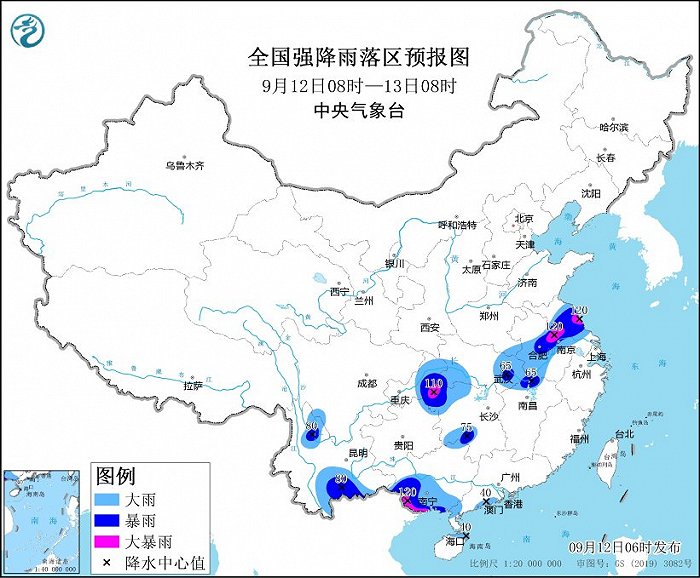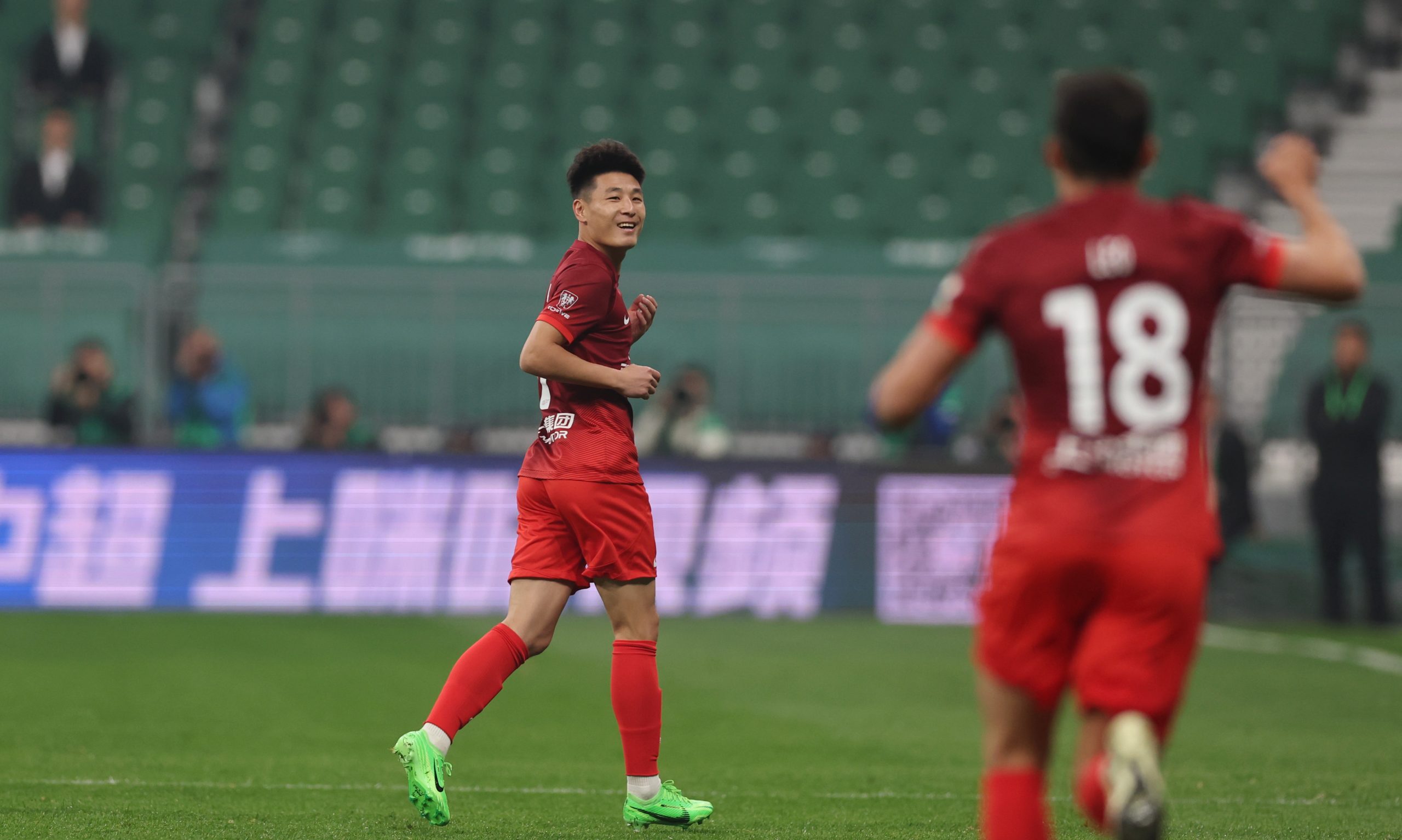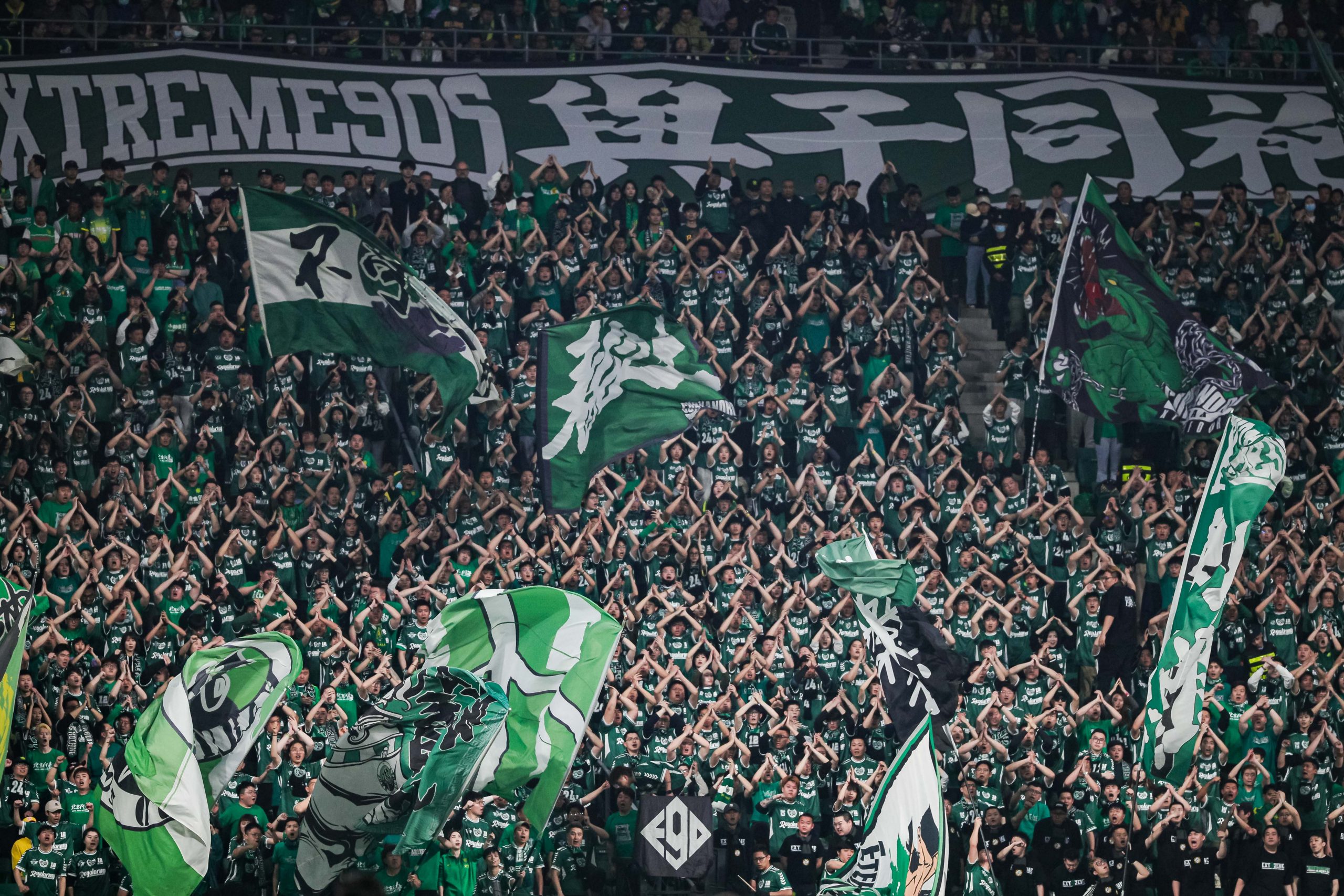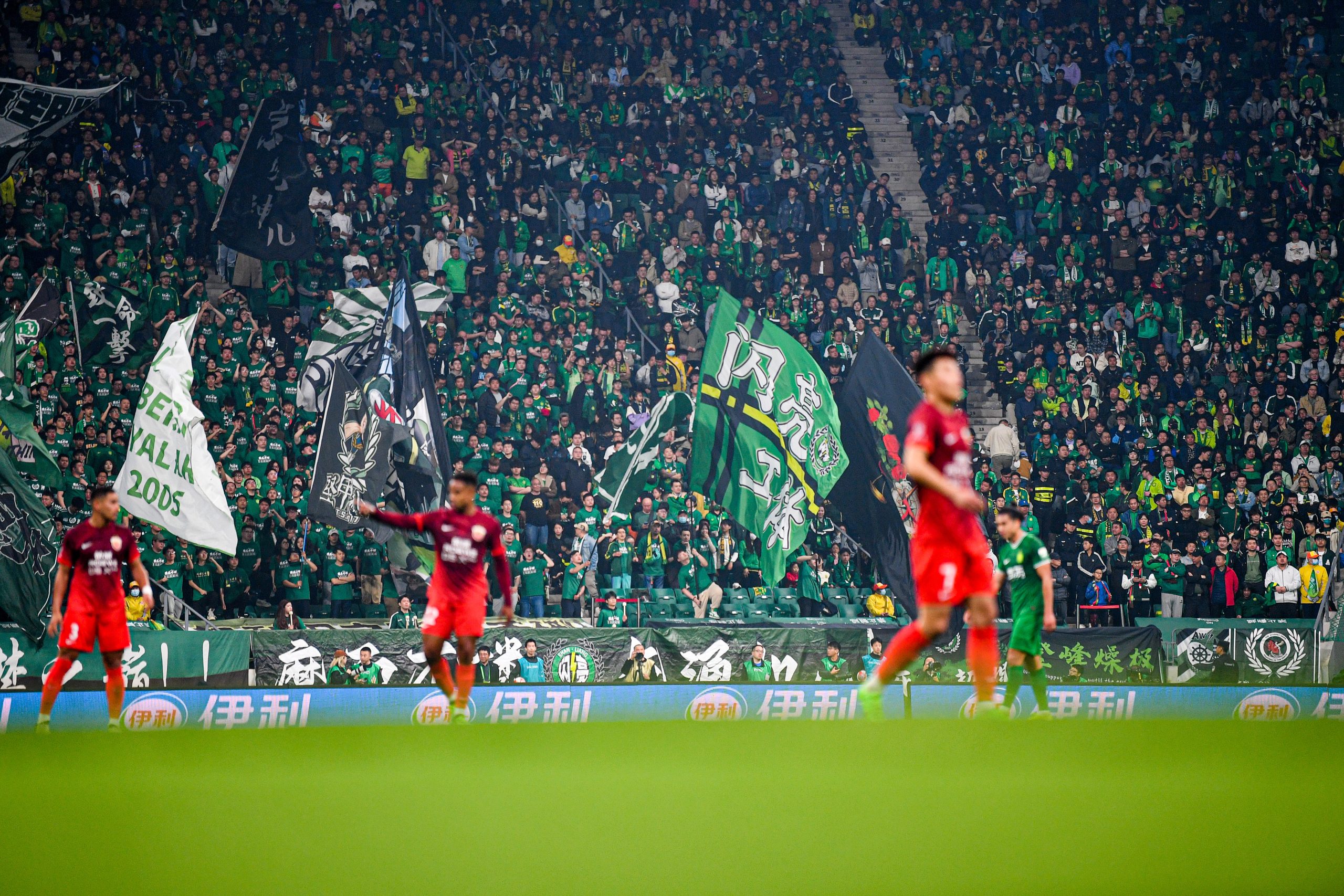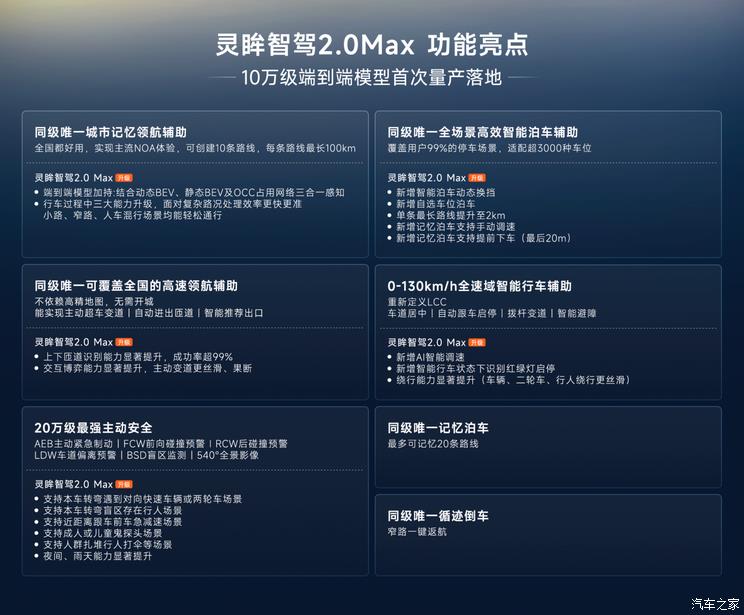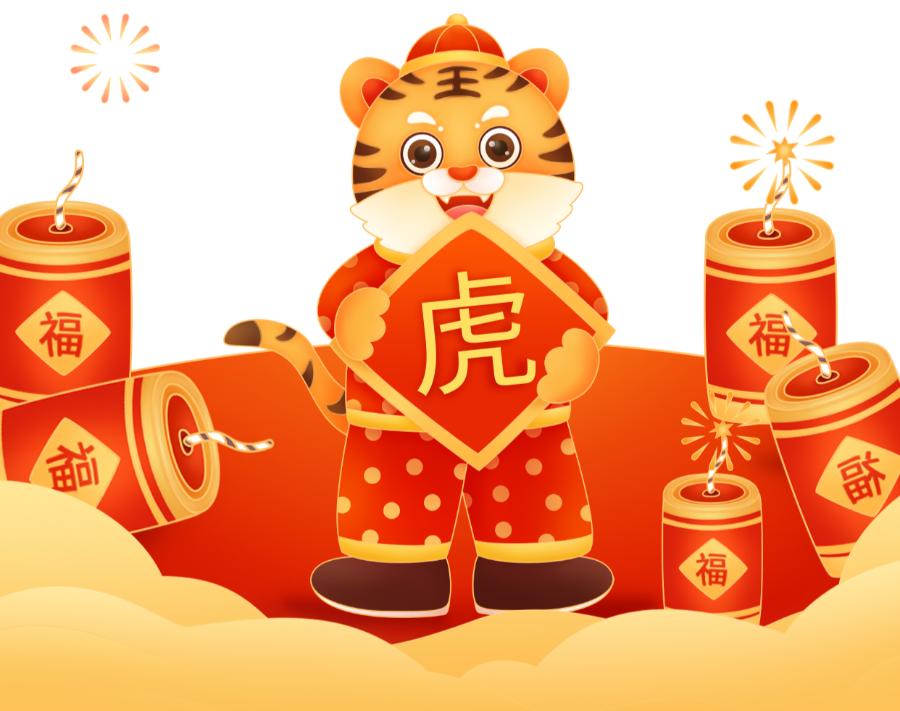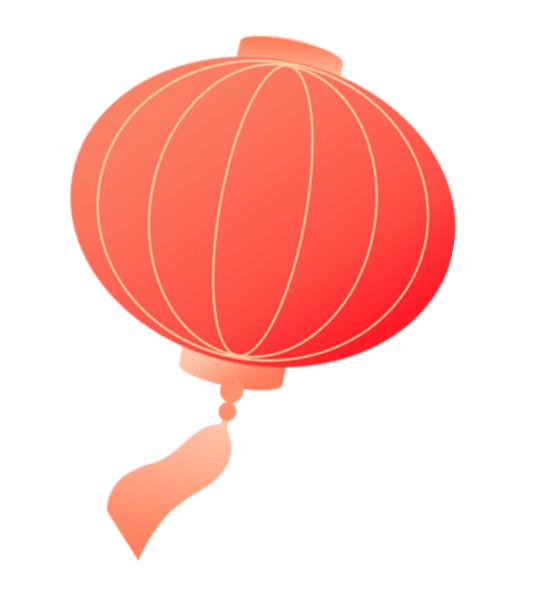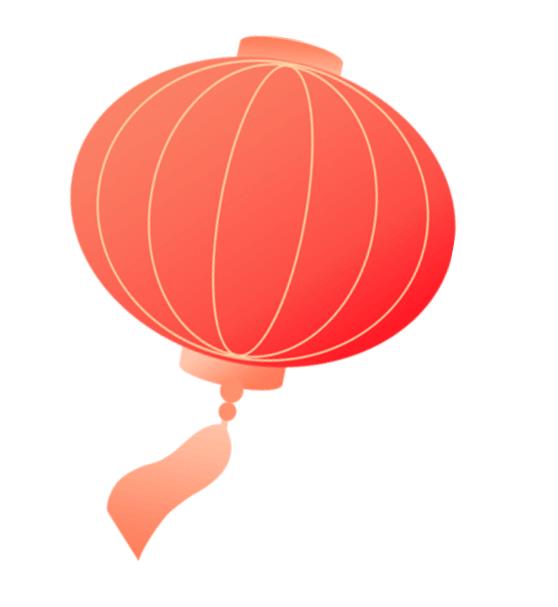Dong Mingzhu is tough and Gree is weak.

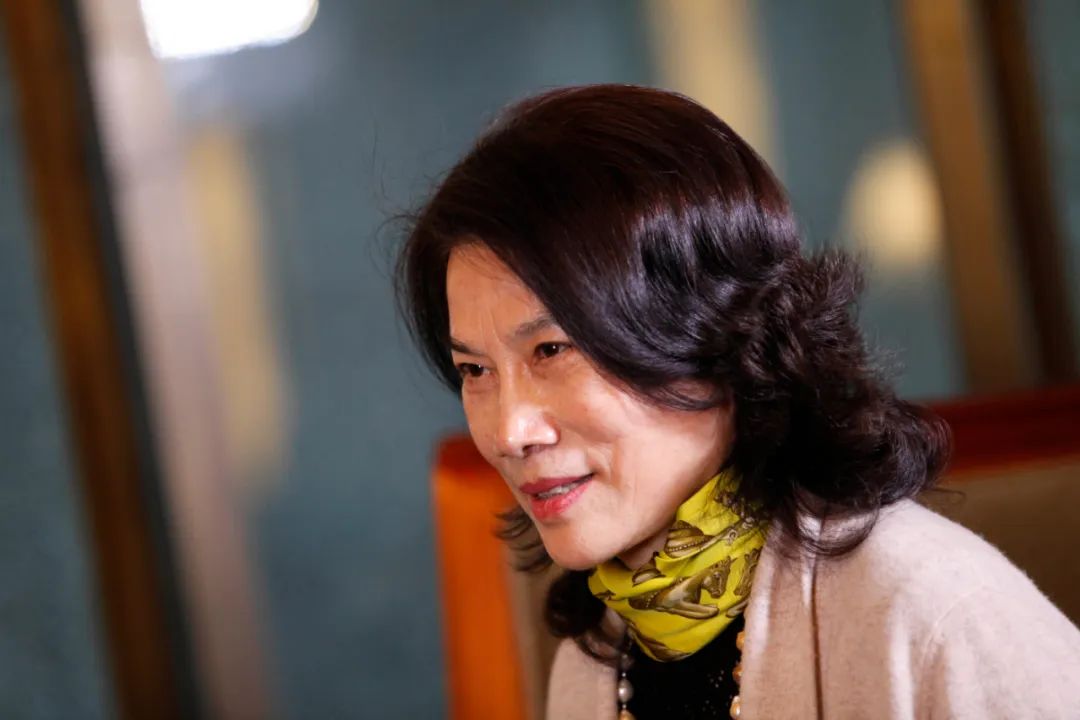
“
Diversified business is hard to say success, and channel reform still needs to be promoted.
"
Author Wang Yuanlei
Dong Mingzhu is never short of topics.
On December 13th, a video of Dong Mingzhu’s speech at the induction ceremony of Gree’s 2023 college students was circulated on the Internet. In his speech, Dong Mingzhu criticized Meng Yutong again, which attracted a lot of attention.
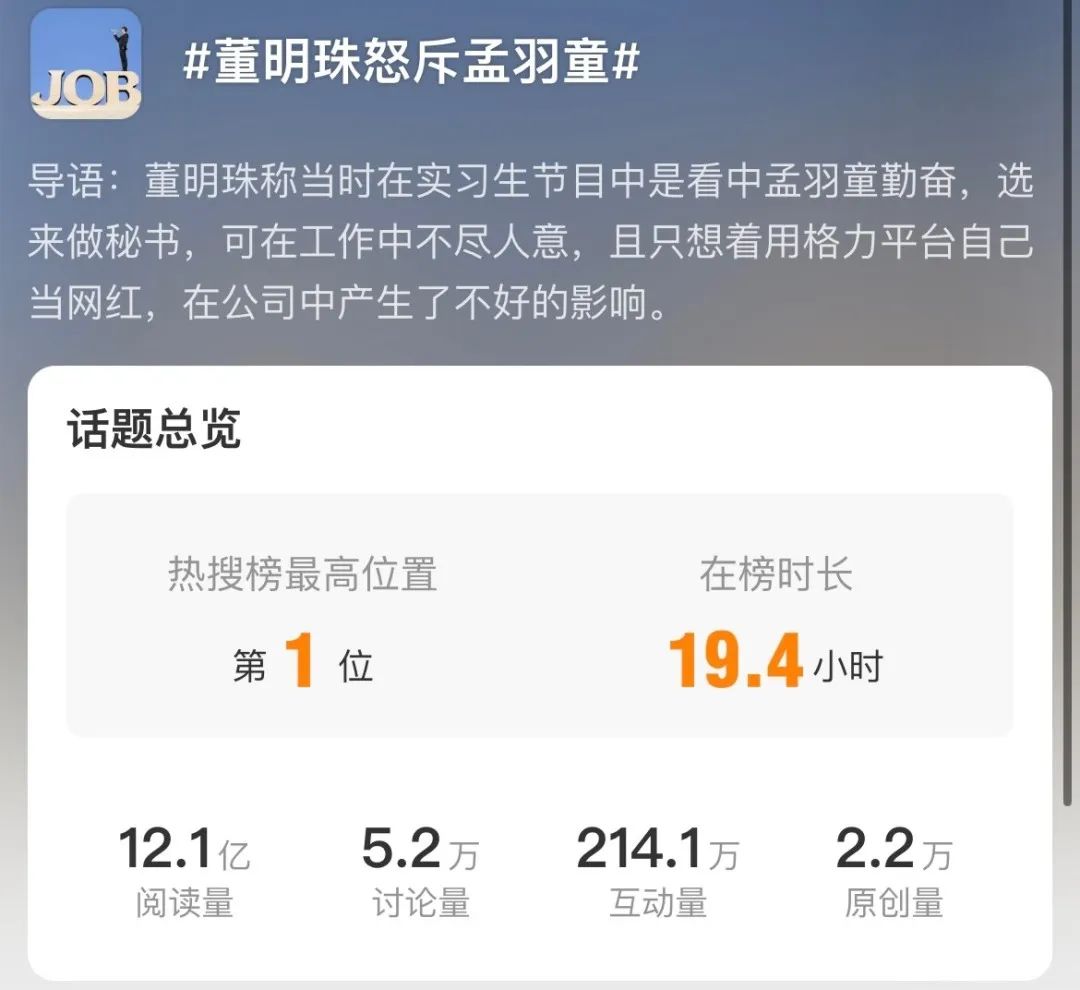
Dong Mingzhu is well versed in marketing.Ten years ago, I gambled with Lei Jun, the founder of Xiaomi, and earned enough traffic for Gree. Two years ago, I made a bold statement to train Meng Yutong, a fresh student, as a successor, and saved hundreds of millions of advertising fees for Gree.
But the problem is that the tougher Dong Mingzhu is, the weaker Gree’s performance is. Although the innovative business has blossomed, Gree is still highly dependent on the air-conditioning business, and its overall revenue and profit are less than expected. Moreover, the channel reform that Dong Mingzhu urgently wants to implement is not ideal.
In early August this year, the 2023 Fortune Global 500 list was released.fail (in) an examination.
When asked "Are you sad?", Dong Mingzhu’s response is still tough: "What’s so sad? It’s not sad at all. It’s better to see the company so healthy and happy than the Fortune 500. What is the significance of the world’s top 500? Just look at the sales revenue. Whether the enterprise is good or not, I know what I know, whether I am sick or not, and I know it. "
0one
Gree’s moat
Gree’s main business is air conditioning, and the difficulties it faces are also mainlyFocus on air conditioning distribution channels.. To understand Gree’s channel dilemma, the story should start from the air-conditioning industry.
The development of air-conditioning industry has a history of one hundred years. From "refrigeration and heating" to "conversion of constant frequency air conditioning" to "intelligent noise reduction and comfortable air supply", air-conditioning technology has been continuously iterated, and the industry has gradually formed giant enterprises such as Gree and Midea, which control most of the market share.
Based on this industry pattern, the competition in the air-conditioning industry is mainly concentrated in three aspects, namelyMarketing, channel and price war. Let’s look at these three points:
In terms of marketing, Dong Mingzhu is recognized as a marketing genius. The "1 billion bet" made Gree earn enough traffic and "cultivated Gree’s successor", and directly promoted his assistant to online celebrity. Dong Mingzhu people were also malicious, and even their own people were embarrassed. They often went to hot search and became Gree’s veritable marketing spokesperson by virtue of people’s appointment.
In terms of price wars, Gree has fought countless price wars in the course of decades of development, from offline store discounts to online live broadcasts, and Gree has repeatedly participated in industry price wars.
In addition to marketing and price factors, looking at the development process of air-conditioning industry, the iterative speed of air-conditioning technology update is slow, and it is basically difficult to open the gap.The real gap lies in the channel..

Any leading enterprise has a strong moat. The channel is the moat of Gree. In the development of more than 30 years, Gree has formed a solid sales channel system-Provincial regional sales companies, county levelAgent, terminal sales outlets.
Among them, Gree holds shares in provincial regional sales companies, and the provincial sales companies directly control county-level agents, and Gree and county-level agents do not settle accounts.
In addition, during the seasonal change in Xia Dong, Gree responded to fluctuations in production byProvide discounts for dealers and return funds for goods.In turn, it is deeply bound with dealers.
Under this channel model, Gree has formed a solid sales channel system in the whole country, which has become the main factor for Gree to sit firmly on the throne of air conditioning overlord for a long time.
02
Fist products are not hard.
However, judging from the development in recent years, Gree’s leading position is being shaken, and one of the main manifestations-fist products are not hard.
As a leader in China’s home appliance industry, Gree’s performance in the secondary market is remarkable. When the stock price is the highest, it is about 62 yuan per share.distribute bonusIn fact, it is a proper "cash cow", so that Dong Mingzhu once said to the outside world, "We have paid more than 100 billion dividends to the stock market, and paying dividends to shareholders every year is the most balanced return on investment."
Behind this is the performance support of fluctuating growth. In July 2019, Gree was selected into the Fortune Global 500 for the first time with a revenue of 198.153 billion yuan, ranking 414th, and its revenue increased by 0.02% year-on-year.net profitIt reached 24.697 billion yuan. Since then, GreecontinuouslyList the top 500 in the world, ranking 436th, 488th and 487th respectively.
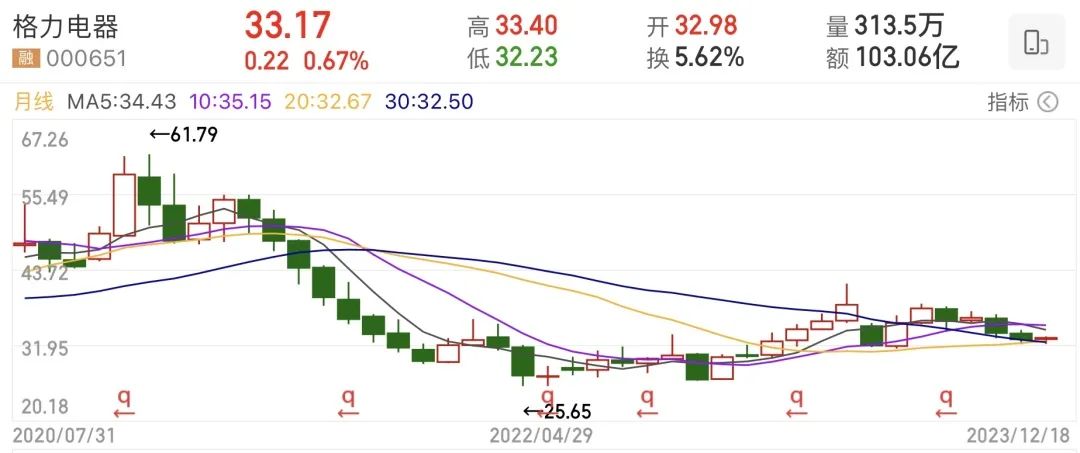
In 2022, Gree’s revenue was 189 billion yuan, a year-on-year increase of 0.6%. "When the moon is full, it will lose money, and when the water is full, it will overflow." Gree’s development track seems to confirm this truth. In this year’s list of the world’s top 500 companies, Gree and the top 500 companies have a revenue difference of 35 billion yuan, which is a pity.
This is not without warning. Since December 2020, Gree’s share price has continued to fall, and it is currently about 33.14 yuan per share.The higher point has dropped by about 45%.The market value evaporated by nearly 200 billion yuan.
On the other hand, its performance is hardly satisfactory. Even in the past three years, Gree’s revenue has not increased significantly. (see the picture below)
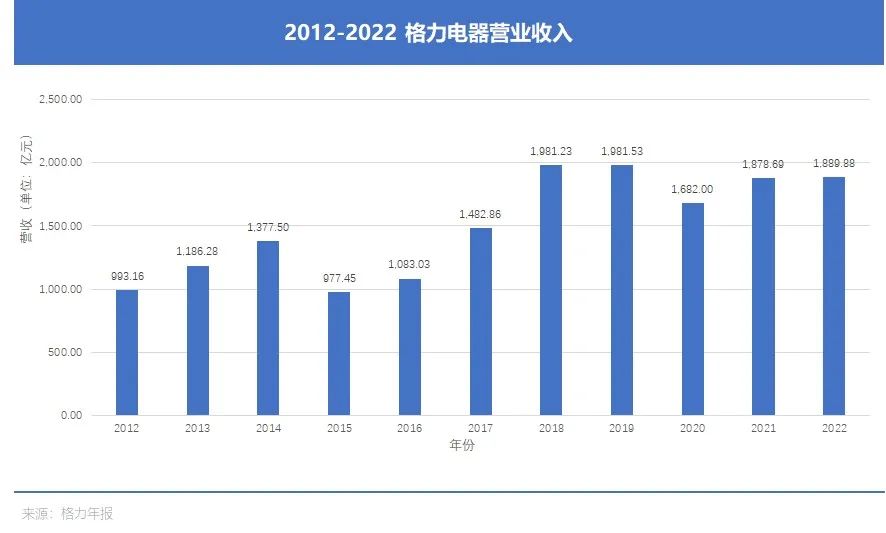
Air conditioning is the lifeblood of Gree, accounting for 71.36% of its revenue in 2022. However, in terms of air conditioning, the most competitive product, Gree’s air conditioning revenue has not increased significantly in the past three years (see the figure below). as soon asmarket shareLook, in 2022, Gree’s home air conditionerThe market share has lost the first place in the market.The throne of.
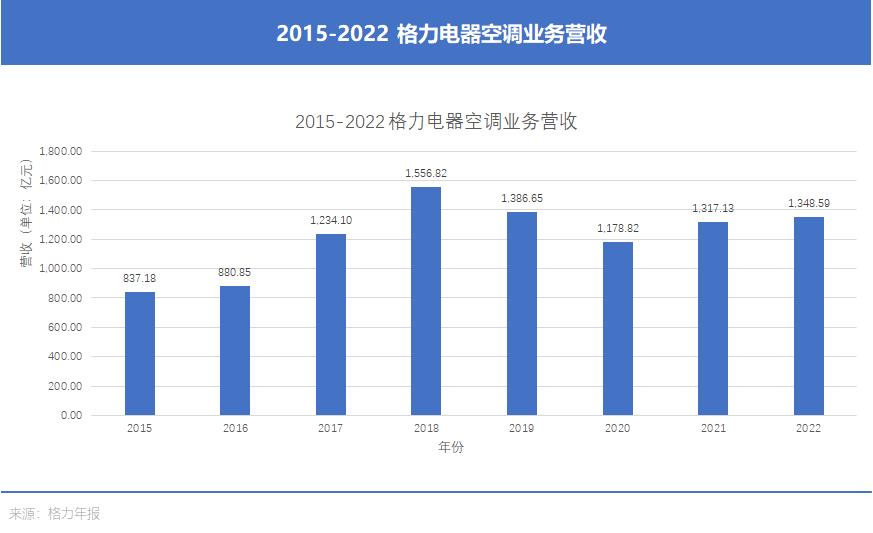
These two years have followedCooling of air conditioning marketThe continuous negative growth of domestic air-conditioning market, coupled with the gradual weakening of air-conditioning season sales by live broadcast, has affected Gree’s overall performance, resulting in unsatisfactory performance.
However, it is worth noting that Midea and Haier continue to grow. As of December 15th, the market value of Midea was 353.5 billion yuan.The market value is 191 billion yuan, and the market value of Gree is over 186.4 billion yuan.Gree is in itAlready at the bottom 2..
Moreover, when Gree fell out of the world’s top 500, Midea and Haier remained among the top 500. Midea has been selected into the Forbes world’s top 500 for eight consecutive years and ranked 278th this year.
Obviously, this can’t be explained by the phrase "poor external environment". In order to promote Gree’s performance growth, Dong Mingzhu has made business adjustments to find a second growth curve.
0three
Gree attacked from all sides.
Knowing and doing are two different things.
Many years ago, Dong Mingzhu has been exploring diversified businesses, but so far, they have all performed poorly. At the two sessions this year, Dong Mingzhu said in the face of media questions, "I think (Gree)Has been transformed successfully, realizing the transformation from a single air conditioner to a full range of household appliances. "
The so-called "all-category household appliances" in Dong Mingzhu include household central air conditioners, household appliances, refrigerators, washing machines, water heaters, water dispensers and various intelligent products, covering all sub-sectors of household appliances.
In addition to the continuous expansion in the field of home appliances, Gree is also involved in many fields such as completely unrelated new energy and intelligent equipment, including cars, energy storage, mobile phones, prefabricated dishes and so on.
The reason why an enterprise is strong is not because of how extensive its products and businesses are, but because it can continuously improve its products and keep innovating. “One meter wide and one hundred meters deep."Is the wisdom of enterprise development.
In the diversified business, one of Gree’s well-known businesses is the acquisition of Yinlong New Energy. In that year, Dong Mingzhu joined Wanda Group in his own name.Five companies, regardless of the opposition, increased their capital by Yinlong New Energy and jointly invested 3 billion yuan.
In 2021, Gree won 47.93% of the voting rights of Yinlong New Energy by participating in the public auction of judicial auction, and Yinlong New Energy became a holding subsidiary of Gree. According to Gree’s 2022 performance report, Yinlong New Energy (now Gree Titanium) has lost more than 1.9 billion yuan and its asset-liability ratio has reached 99%.

In addition to this acquisition, the mobile phone business has also made Dong Mingzhu frequently out of the circle. In 2016, Dong Mingzhu boasted in a speech, "I am proud to say that my mobile phone is the first in the world, not the first in sales. At least I promise consumers that my quality is the first."
But the question is, is the quality of Gree mobile phone really the best in the world? Up to now, Gree mobile phones have launched a total of six models. No matter from which point of view, Gree mobile phones are hardly successful.
These are diversified businesses promoted by Gree. On the whole, Gree’s business is mainly divided into five sections, namelyAir conditioning,life electric、industrial product、intelligent equipmentandGreen energy. In addition, there are some innovative businesses with relatively low revenue, includingMedical health, prepared vegetables, semiconductorsWait.
Judging from the layout timeline, doing what the track fires can, to a certain extent, summarize the diversified business characteristics of Gree, which is doomed to be difficult to achieve success.
In 2020, Dong Mingzhu started live broadcasting with goods in Tik Tok, and over 10 live broadcasts were conducted that year, with a total of nearly 50 billion yuan of goods. With its own efforts, Dong Mingzhu achieved Gree’s sales performance in the last quarter.
This also made Dong Mingzhu see a new direction-live broadcast with goods, so Meng Yutong came to the stage. In September, 2021, Dong Mingzhu recruited Meng Yutong as a secretary, and made a strong platform for Meng Yutong, publicly expressing that he would train Meng Yutong as his successor. During this period, Meng Yutong frequently appeared in online live broadcast rooms.
However, it is worth noting that live delivery has indeed increased the proportion of online sales, but in this way, it has had an impact on Gree’s existing distribution channel system.
0four
Disadvantages of channels
During the "June 18th" promotion in 2020, Dong Mingzhu took the goods off the live broadcast, setting a new record that the single live broadcast sales exceeded 10 billion. Interestingly, however, two days later, Jinghai Internet, a provincial distributor alliance, reduced its holdings of Gree. In July of that year, Jinghai Internet reduced its holdings again.

This is the provincial regional sales company expressing its dissatisfaction with Gree. Dong Mingzhu’s first live broadcast performance was bleak, but in the later live broadcast, the performance was getting better and better, and the reason could not be separated from the help of dealers.
Dong Mingzhu launched offline dealer drainage in the live broadcast. Consumers placed orders through the exclusive QR code shared by dealers, and Gree headquarters directly delivered them, and thenBypass the provincial regional sales companies.. As a result, there was a scene of the counterattack of the provincial marketing department.
In fact, Gree’s sales channels have always had disadvantages. In the course of perennial operation, Gree has formed a community of interests with all links in the channels, but there are obvious problems in this deep binding relationship.
First of all, Gree should be the channel.Leave enough profit margin.Once the profit is reduced, all links in the distribution will lose the motivation to sell goods. Secondly, Gree does not have direct settlement with county-level agents, and there is no direct contact. Gree does not have much right to speak in the intermediate link between provincial sales companies and county-level agents.
In order to develop live broadcast with goods and increase the proportion of online sales in Dong Mingzhu, it is necessary to go beyond the level of provincial sales companies. Moreover, under the background of the great cooling of the air-conditioning market, Gree’s channel system is even more bloated.
There has never been a smooth reform. If Dong Mingzhu wants to move the channel system, it will naturally encounter a lot of resistance. So far, it is still hard to say success. However, the transformation of Gree’s old rival Midea has achieved results.
In 2017, Midea changed its sales company into an operation center. As a result, it changed from earning the difference to earning the service fee, and finally the beauty was formed.twoLevel sales system-factories and distributors.
This change not only reduces the intermediate links, further reduces the cost, but also strengthens the brand’s control over the terminal. Whether it is a price war or a promotion of new products, Midea is more handy.
In 2019,Midea overtook Gree in market share.Since then, the air-conditioning market has been easy to attack and defend, and Gree’s hegemony has changed hands.

according toAccording to the 2022 performance report, according to the data of Aowei Cloud, Midea’s products are online and offline in China in six categories, including household air conditioners, desktop microwave ovens, electric heaters, induction cookers and electric kettles.Market share ranks first in the industry..
Among them, the offline market share of household air conditioners is 33.7%, and the online market share is 33.6%.Ranked first in the industry..
0five
Dong Mingzhu can’t solve this problem.
While reforming the channel system, Gree has been promoting the development of diversified businesses in the past decade, changing the single air-conditioning business structure into an air-conditioning business system driven by multi-core businesses.
However, many business lines that have been tried to develop are average. In 2022, Gree air-conditioning business revenue was 134.859 billion yuan, accounting for 71.36% of the total revenue. Compared with 70.11% in 2021, the proportion of air-conditioning business has not decreased, but has increased by 1.25%.
Looking at the timeline, diversified business attempts, although not ineffective, have indeed declined in the proportion of air-conditioning business, butIt still accounts for more than 70% of total revenue.For a behemoth like Gree, it is hard to say that it is a success. (see the picture below)
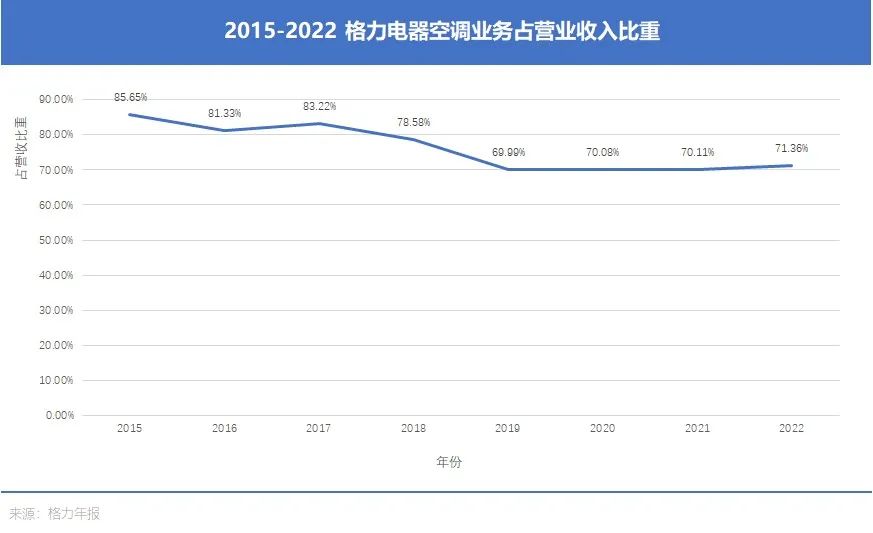
At the same time, rivals such as Midea, Haier and Oaks are actively transforming. In addition to the changes in channels, Midea is relatively more successful in business, and has formed a business system focusing on HVAC and consumer appliances, andThere is a small gap between the two businesses in revenue.The overall safety margin is high. (see the picture below)
In 2022, Midea achieved a total revenue of 345.7 billion yuan, a year-on-year increase of 0.68%, which has exceeded Gree by hundreds of billions of yuan.
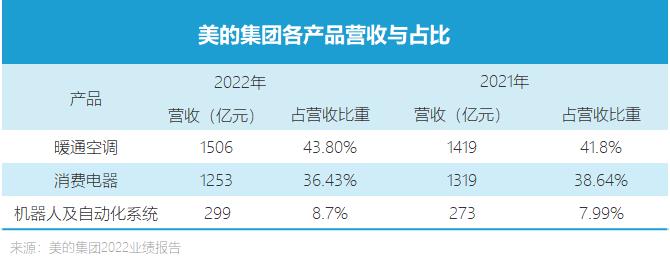
In 2021, after Meng Yutong joined Gree in a high profile, Dong Mingzhu praised Meng Yutong in the early stage, saying that Meng Yutong "is a person who will not be tempted by external things" and "hopes to spend five years (so that she can) in a very high position", and even went so far as to cultivate a successor.
Now the ending is clear. Meng Yutong left after less than two years in Gree, and managed the "Pearl Feather Boy Selection" (changed to "Gree Pearl Selection")Tik Tok account successfully sucked nearly 3 million powder.. However, it should be noted that live broadcast with goods is difficult to become the fundamental path for Gree to solve problems, and in terms of brands,live-streamingBring goodsIt is also a "double-edged sword".

This year is the first year out of the epidemic. Although the epidemic has ended, the economic development is still under great pressure. The development of domestic investment, consumption and export is less than expected, and the pessimism in the real estate market still exists. Affected by the development of the real estate industry, the air-conditioning industry has also been affected.
At the same time, live e-commerce and interest e-commerce have developed rapidly, the pattern of white electricity market has been rapidly reshaped, and online direct sales have surged. Gree’s distribution system is losing its advantages in the offline era, and it is even more powerless to cope with market changes.
Dong Mingzhu was born in 1954, and now he is 69 years old. Although Dong Mingzhu has repeatedly stressed that "I think my mind is young, like 25 years old", time and tide wait for no man. Facing the ever-changing technological changes, market environment and young consumers’ demands, I’m afraid Dong Mingzhu can’t untie the knot that Gree has unscrewed.
0six
tag
In 2013, on the CCTV stage, faced with the proposal that Lei Jun’s millet turnover could surpass Gree in the next five years, he wanted to bet one yuan. Dong Mingzhu boldly said that he would "bet one billion".
This is a confrontation between the traditional "one brother in manufacturing" and the new economic enterprises. Five years later, standing at the time of 2018, Xiaomi lost Gree. At that time, Gree’s performance was still growing, and Dong Mingzhu also had enough confidence to fight Xiaomi.
However, shortly thereafter, Lei Jun talked about the second gambling contract, while Dong Mingzhu changed his old car-scrapping, symbolically responding "He is willing to renew, of course I can". The reason is self-evident. Dong Mingzhu knows better than the outside world that Gree has reached the top of the mountain on the ramp of air conditioning.
Over the top of the mountain, it is downhill..
After leaving his post, Meng Yutong, the former secretary, talked about topics such as work intensity, working hours and salary on social platforms.
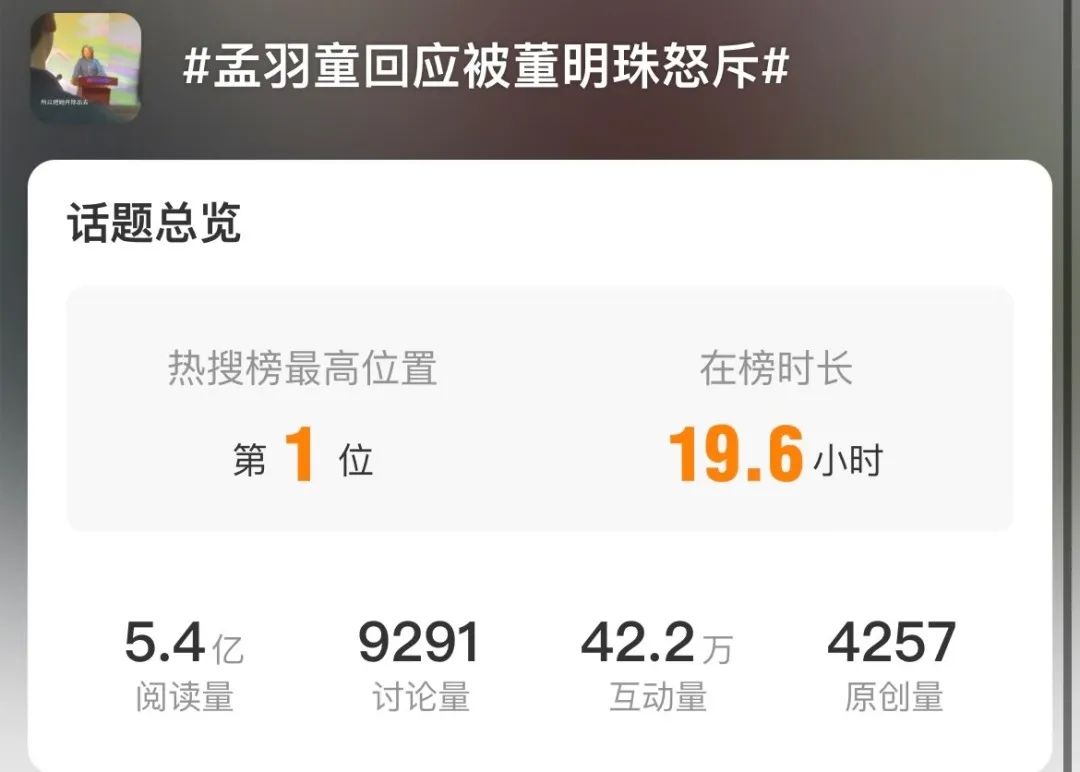
Dong Mingzhu repeatedly responded to Meng Yutong’s departure on different occasions. On November 6, in an interview with Caijing Langyan, he said frankly, "It is impossible to advertise on the platform of Gree and then go outside. This is definitely illegal."
According to the video shared by Tik Tok user "Jeanette Mud Duck", Dong Mingzhu once again mentioned Meng Yutong in his induction speech, saying that he only wanted to use Gree platform as his own online celebrity, which had a bad influence in the company. And said that just thinking about making more money is no different from walking dead.
The grey line of grass snake is a thousand miles long. By comparing Dong Mingzhu’s attitude towards employees and the concept of employing people, it is not difficult to understand Gree’s present situation.
In the face of the accelerated new era of artificial intelligence, the younger generation with more diversified needs, and the changes in online direct sales channels, I am afraid that Gree can win the next battle through the cycle.It will take time to test..
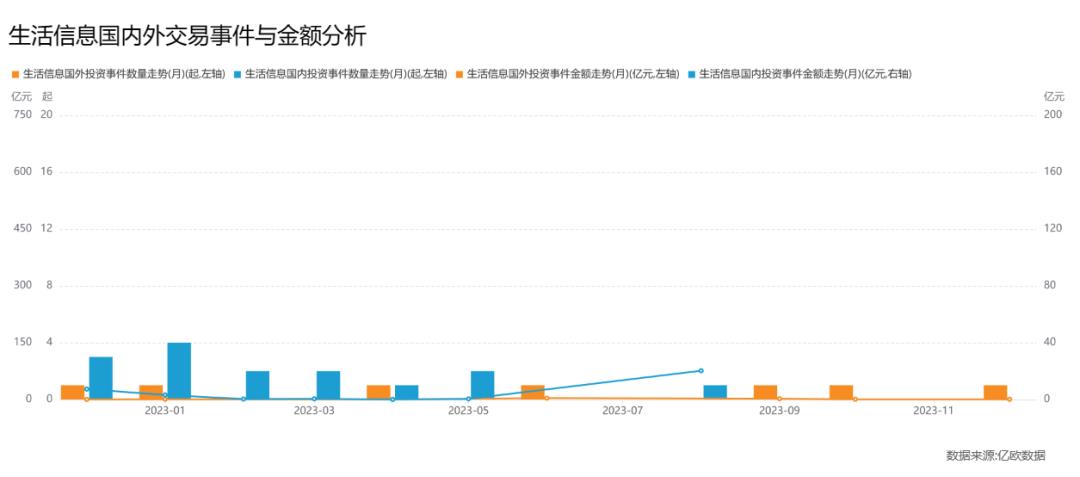
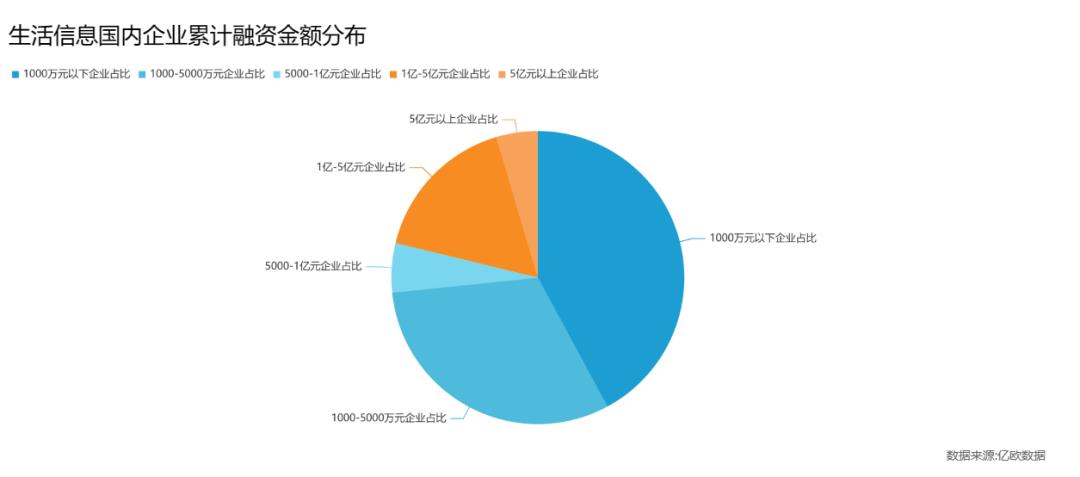
References:
1. Dong Mingzhu responded to Gree’s "failure" this year for the first time: better than the world’s top 500 mines. First Finance.
2. Don’t be too hard on Meng Yutong.
3. Dong Mingzhu’s many remarks against employees’ job-hopping were hotly discussed by netizens. Securities Times.
4. Dong Mingzhu refuses to accept: the Schrodinger ending of Gree’s diversification. What Wall Street has seen.
5. Dong Mingzhu said that Gree’s mobile phone quality is the first in the world, and its daily sales volume is expected to reach 100,000 units. Interface news.
6. There is a Wang Ziru between Dong Yuhui and Meng Yutong.
710 million gambling. Baidu Encyclopedia.
On November 6, 8, Caijing Langyan.
9. Gree Dong Mingzhu can’t let go of Meng Yutong.
10. Dong Mingzhu: Create your own marketing model and "revolutionize" yourself. Xinhua Daily Telegraph.
11. Gree Electric Annual Performance Report for 2012-2022.
12. Midea Group’s annual performance report for 2019-2022.
13. Haier Zhijia’s 2019-2022 annual performance report.
